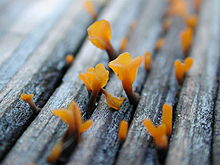| Dacryopinax | |
|---|---|
 | |
| Dacryopinax spathularia | |
| Scientific classification | |
| Domain: | Eukaryota |
| Kingdom: | Fungi |
| Division: | Basidiomycota |
| Class: | Dacrymycetes |
| Order: | Dacrymycetales |
| Family: | Dacrymycetaceae |
| Genus: | Dacryopinax G.W.Martin (1948) |
| Type species | |
| Dacryopinax elegans (Berk. & M.A.Curtis) G.W.Martin (1948) | |
| Species | |
~15; see text | |
Dacryopinax is a genus of fungi in the family Dacrymycetaceae. The genus is widespread, especially in tropical regions, and contains about 15 species. [1] Dacryopinax was circumscribed by American mycologist George Willard Martin in 1948. [2] A taxonomic monograph was published by McNabb (1965). [3]
Dacryopinax species are common wood inhabiting fungi worldwide, mostly producing brown rot wood decay. Genomic analysis of Dacryopinax primogenitus revealed the loss of genes for class II peroxidases necessary for lignin degradation, supporting observations of a brown rot physiology. [4]